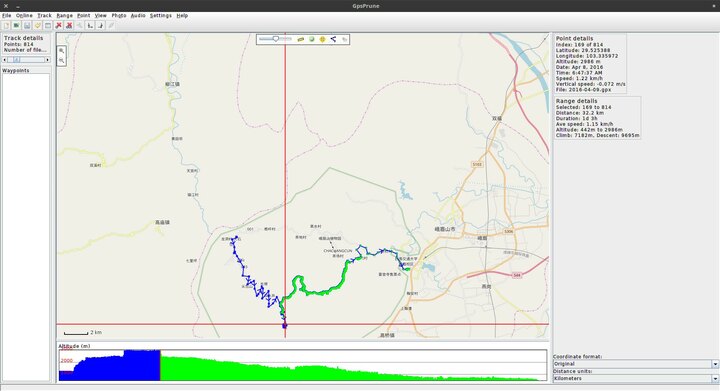Nearly all self-hosted location tracking Android applications are based on server-client architecture: the one on the phone collects only a small points, if not only one, and sends it to a configured server. Traccar1, Owntracks2, etc.
While this setup is useful, it doesn't fit in my static, unless it hurts3 approach, and it needs data connectivity, which can be tricky during abroad trips. The rare occasions in rural Scotland and Wales tought me data connectivity is not omnipresent at all.
There used to be a magnificent little location tracker, which, besides the server-client approach, could store the location data in CSV and KML files locally: Backitude4. The program is gone from Play store, I have no idea, why, but I have a copy of the last APK of it5.
My flow is the following:
- Backitude saves the CSV files
- Syncthing6 syncs the phone and the laptop
- the laptop has a Python script that imports the CSV into SQLite to eliminate duplicates
- the same script queries against Bing to get altitude information for missing altitudes
- as a final step, the script exports daily GPX files
- on the laptop, GpsPrune helps me visualize and measure trips
Backitude configuration
These are the modified setting properties:
- Enable backitude: yes
- Settings
- Standard Mode Settings
- Time Interval Selection: 1 minute
- Location Polling Timeout: 5 minutes
- Display update message: no
- Wifi Mode Settings
- Wi-Fi Mode Enabled: yes
- Time Interval Options: 1 hour
- Location Polling Timeout: 5 minutes
- Update Settings
- Minimum Change in Distance: 10 meters
- Accuracy Settings
- Minimum GPS accuracy: 12 meters
- Minimum Wi-Fi accuracy: 20 meters
- Internal Memory Storage Options
- KML and CSV
- Display Failure Notifications: no
- Standard Mode Settings
I have an exported preferences file available7.
Syncthing
The syncthing configuration is optional; it could be simple done by manual transfers from the phone. It's also not the most simple thing to do, so I'll let the Syncting Documentation8 take care of describing the how-tos.
Python script
Before jumping to the script, there are 3 Python modules it needs:
pip3 install --user arrow gpxpy requestsAnd the script itself - please replace the INBASE,
OUTBASE, and BINGKEY properties. To get a Bing
key, visit Bing9.
import os
import sqlite3
import csv
import glob
import arrow
import re
import gpxpy.gpx
import requests
INBASE="/path/to/your/syncthing/gps/files"
OUTBASE="/path/for/sqlite/and/gpx/output"
BINGKEY="get a bing maps key and insert it here"
def parse(row):
DATE = re.compile(
r'^(?P<year>[0-9]{4})-(?P<month>[0-9]{2})-(?P<day>[0-9]{2})T'
r'(?P<time>[0-9]{2}:[0-9]{2}:[0-9]{2})\.(?P<subsec>[0-9]{3})Z$'
)
lat = row[0]
lon = row[1]
acc = row[2]
alt = row[3]
match = DATE.match(row[4])
# in theory, arrow should have been able to parse the date, but I couldn't get
# it working
epoch = arrow.get("%s-%s-%s %s %s" % (
match.group('year'),
match.group('month'),
match.group('day'),
match.group('time'),
match.group('subsec')
), 'YYYY-MM-DD hh:mm:ss SSS').timestamp
return(epoch,lat,lon,alt,acc)
def exists(db, epoch, lat, lon):
return db.execute('''
SELECT
*
FROM
data
WHERE
epoch = ?
AND
latitude = ?
AND
longitude = ?
''', (epoch, lat, lon)).fetchone()
def ins(db, epoch,lat,lon,alt,acc):
if exists(db, epoch, lat, lon):
return
print('inserting data point with epoch %d' % (epoch))
db.execute('''INSERT INTO data (epoch, latitude, longitude, altitude, accuracy) VALUES (?,?,?,?,?);''', (
epoch,
lat,
lon,
alt,
acc
))
if __name__ == '__main__':
db = sqlite3.connect(os.path.join(OUTBASE, 'location-log.sqlite'))
db.execute('PRAGMA auto_vacuum = INCREMENTAL;')
db.execute('PRAGMA journal_mode = MEMORY;')
db.execute('PRAGMA temp_store = MEMORY;')
db.execute('PRAGMA locking_mode = NORMAL;')
db.execute('PRAGMA synchronous = FULL;')
db.execute('PRAGMA encoding = "UTF-8";')
files = glob.glob(os.path.join(INBASE, '*.csv'))
for logfile in files:
with open(logfile) as csvfile:
try:
reader = csv.reader(csvfile)
except Exception as e:
print('failed to open CSV reader for file: %s; %s' % (logfile, e))
continue
# skip the first row, that's headers
headers = next(reader, None)
for row in reader:
epoch,lat,lon,alt,acc = parse(row)
ins(db,epoch,lat,lon,alt,acc)
# there's no need to commit per line, per file should be safe enough
db.commit()
db.execute('PRAGMA auto_vacuum;')
results = db.execute('''
SELECT
*
FROM
data
ORDER BY epoch ASC''').fetchall()
prevdate = None
gpx = gpxpy.gpx.GPX()
for epoch, lat, lon, alt, acc in results:
# in case you know your altitude might actually be valid with negative
# values you may want to remove the -10
if alt == 'NULL' or alt < -10:
url = "http://dev.virtualearth.net/REST/v1/Elevation/List?points=%s,%s&key=%s" % (
lat,
lon,
BINGKEY
)
bing = requests.get(url).json()
# gotta love enterprise API endpoints
if not bing or \
'resourceSets' not in bing or \
not len(bing['resourceSets']) or \
'resources' not in bing['resourceSets'][0] or \
not len(bing['resourceSets'][0]) or \
'elevations' not in bing['resourceSets'][0]['resources'][0] or \
not bing['resourceSets'][0]['resources'][0]['elevations']:
alt = 0
else:
alt = float(bing['resourceSets'][0]['resources'][0]['elevations'][0])
print('got altitude from bing: %s for %s,%s' % (alt,lat,lon))
db.execute('''
UPDATE
data
SET
altitude = ?
WHERE
epoch = ?
AND
latitude = ?
AND
longitude = ?
LIMIT 1
''',(alt, epoch, lat, lon))
db.commit()
del(bing)
del(url)
date = arrow.get(epoch).format('YYYY-MM-DD')
if not prevdate or prevdate != date:
# write previous out
gpxfile = os.path.join(OUTBASE, "%s.gpx" % (date))
with open(gpxfile, 'wt') as f:
f.write(gpx.to_xml())
print('created file: %s' % gpxfile)
# create new
gpx = gpxpy.gpx.GPX()
prevdate = date
# Create first track in our GPX:
gpx_track = gpxpy.gpx.GPXTrack()
gpx.tracks.append(gpx_track)
# Create first segment in our GPX track:
gpx_segment = gpxpy.gpx.GPXTrackSegment()
gpx_track.segments.append(gpx_segment)
# Create points:
gpx_segment.points.append(
gpxpy.gpx.GPXTrackPoint(
lat,
lon,
elevation=alt,
time=arrow.get(epoch).datetime
)
)
db.close()Once this is done, the OUTBASE directory will be
populated by .gpx files, one per day.
GpsPrune
GpsPrune is a desktop, QT based GPX track visualizer. It needs data connectivity to have nice maps in the background, but it can do a lot of funky things, including editing GPX tracks.
sudo apt install gpspruneKeep it in mind that the export script overwrites the GPX files, so the data needs to be fixed in the SQLite database.
This is an example screenshot of GpsPrune, about our 2 day walk down from Mount Emei and it's endless stairs:

Happy tracking!
(Oh, by the way: this entry was written by Peter Molnar, and originally posted on petermolnar dot net.)